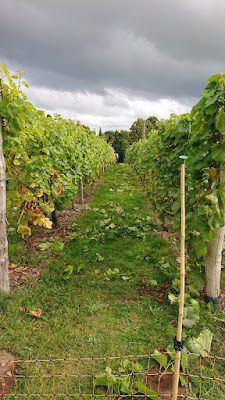The Royal Horticultural Society has produced wine from plantings of Orion and Phoenix grapes vinified by Plumpton College.
 |
| The sign on the post says 'Orion' |
At their small vineyard at Wisley there are a few rows of 63 mixed varieties and a further 30-odd are apprently grown under glass. These trials are presumably to test which varieties suffer most from fungal diseases here in the UK.
Walking the vineyard on September 9th this year there was plenty of evidence of fungal diseases despite RHS staff de--leafing the vines. Predictably, some varieties were fairing better than others. We are keen to hear what the official results will be.
Here are extract from a report by the RHS person involved in these trials. His name, appropriately is Gerard Clover:
The Royal Horticultural Society at Wisley has a collection of approximately 100 grapevine (mainly Vitis vinifera) cultivars. These cultivars have been collected since the 1970s and include table and wine grapes grown in the field and under glass. In August 2014, the viral status of the collection was assessed by taking samples of leaves and petioles from eight cultivars selected at random. ... Amplicons of the expected size were obtained using samples from cultivars Nero, Theresa, Queen of Esther and Seyval Blanc.... further samples were obtained from amongst the 39 grapevine (V. labrusca and V. vinifera) cultivars which were planted in 1992 as part of the National Fruit Collection in Faversham, Kent. Samples of leaves and petioles were collected in August 2014 from eight cultivars selected at random and were tested as described previously. Amplicons of the expected size were obtained using samples from V. vinifera cvs. Dunkelfelder, Faberrebe, Madeleine Angevine, Regner and Siegerrebe.....
All riveting stuff.
The vines at Wisley are surrounded by a low electric fence to keep the badgers and others out. By good fortune one of the RHS staff who was de-leafing allowed us to step over this fence (which was not switched on) and check out the 63 varieties planted in the last 4 rows. These were both wine and table grapes. Quite a few unlikely ones were bearing fruit. Whether these grapes might ripen in a decent year is no doubt part of the trials.
It would be interesting to know more about how the RHS obtained all these vines. Some are truly obscure. Here is the list;
Adelheidtraube (not listed in Galet)
Arnsburger
Aurora
Auxerrois
Chasselas Dore 1921
Ciotat (= Chasseles Ciotat)
Elbling
Muscat de Saumur
Melon de Bourgogne
Madeleine Silvaner
Madeleine Royale
Lakemont
Jubilaumsrebe
Interlaken
Huxelrebe
Himrod
Gruener Veltliner
Goldriesling
GM 6414-36 (Ehrenbreitsteiner)
Gewuertztraminer
Gelber Muskateller
Irsai Oliver
Perle de Czaba
Pinot Blanc
Pinot Gris
Pizzutella (aka. Melon de Bougogne)
Precoce de Malingre
Reine O...(?)
Rauschling
Sauvignon Blanc
Schoenburger
Theresa (Teresa Pirovano?)
Triompherebe (aka Triomphe d'Alsace)
Wuerzburger Perle (?)
Theklatraube (not listed in Galet)
Fragola
Siegerrebe
Dornfelder
Miller's Burgundy (Pinot Meunier)
Chambourcin
Zweigeltrebe
Slade Blue (not listed in Galet)
Seibel 13053 (= Cascade)
Rondo
Regent
Queen of Esther (not listed in Galet)
Portugieser
Plantet
Pinot Noir
Noir Hatif de Marseille
Marechal Foch
Leon Millot
Landot 3217 (Galet has Landot 4511 and 244 but not 3217)
Gamay Hatif
Gagarin Bleu
Cot Precoce de Tours
Bacchus
Boskoop Glory
Black Cluster (could be Pinot Meunier, Pinot Noir, Black July, Jaquez or Perrum Tinto)
Baco 1
Acolon










1 comment:
Scoop!
Post a Comment